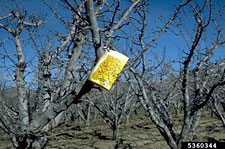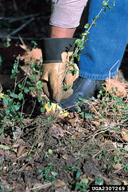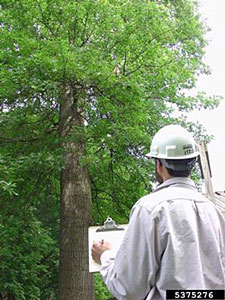Principles of Integrated Pest Management (IPM)
Identify pests, their hosts and beneficial organisms before taking action
The cause of the problem and associated plant or animal species must be correctly identified. For many plant problems, the damage is not caused by insects! If you can't find a pest, consider other causes, including abiotic (non-living) disorders, such as sunscald, wind or cold damage, inadequate moisture, etc.
If you find an insect pest, the Nevada Department of Agriculture State Entomologist can help identify insects, spiders, and other such pests. For instructions on submitting an insect or spider for identification, see Forms and Instructions. Once the pest is identified, determine the pest's life cycle, growth cycle and reproductive habits. Don't focus only on pest organisms! Pest managers should be able to identify all life stages of beneficial organisms, such as the lady bird beetle (ladybug), an insect predator.
This beneficial insect, the lady bird beetle (left), is munching on aphids.The larva (right), which also consumes aphids, looks very different. Learn to recognize all life stages of both beneficial and pest insects.
Photo credits: Ladybug eating aphid - Extension; Ladybug larva - Joseph Berger, Bugwood.org
The cause of the problem and associated plant or animal species must be correctly identified. For many plant problems, the damage is not caused by insects! If you can't find a pest, consider other causes, including abiotic (non-living) disorders, such as sunscald, wind or cold damage, inadequate moisture, etc.
If you find an insect pest, the Nevada Department of Agriculture State Entomologist can help identify insects, spiders, and other such pests. For instructions on submitting an insect or spider for identification, see Forms and Instructions. Once the pest is identified, determine the pest's life cycle, growth cycle and reproductive habits. Don't focus only on pest organisms! Pest managers should be able to identify all life stages of beneficial organisms, such as the lady bird beetle (ladybug), an insect predator.
Establish monitoring guidelines for each pest species
Routine monitoring of both pests and natural enemies, also known as beneficial organisms, is an important part of IPM. Methods of monitoring include visual inspection, pheromone and sticky traps, and sweep nets. Document and track both pest and beneficial organism population numbers. The ratio of natural enemies (usually insects) to pests should be taken into account before a pesticide is applied.

Sticky traps are useful tools for monitoring as well as timing controls.
Photo credit Howard F. Schwartz, Colorado State University, Bugwood.org
Establish an action threshold for the pest
A fundamental concept of IPM is that a certain number of individual pests can and should be tolerated. Farmers start by determining whether the pest will cause unacceptable damage to the value of their crop. What will happen if no action is taken? The action threshold in crop production is generally based on economics. The economic threshold is defined as the pest population level that produces damage equal to the cost of preventing damage by controlling the pest. The threshold is the pest density, or population level, at which management should occur. Homeowners may be more concerned about the appearance of their landscape and may set an aesthetic threshold, rather than one based on economics.
Evaluate and implement control tactics
Select tactics that will be most effective, economical and have least impact on non-target species and the environment. Select methods that will impact beneficial organisms as little as possible while suppressing the pest. If a pesticide is one of the selected management tools, beneficial enemies (usually insects) will likely also be killed.

Pulling can be an effective method of controlling annual and
biennial weeds with minimal impact on the environment.
Photo credit: James H. Miller, USDA Forest Service, Bugwood.org
Monitor, evaluate and document the results
This allows you to make adjustments to improve the effectiveness of future pest management strategies.
Keep records to help you determine what worked well, and what to change next year.

Use routine monitoring to determine the success of your management strategies.
Photo credit: Andrew Koeser, International Society of Arboriculture, Bugwood.org
Hefner, M.
2019,
Principles of Integrated Pest Management (IPM),
Extension | University of Nevada, Reno. IP


